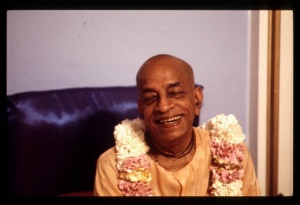CC Madhya 20.217

A.C. Bhaktivedanta Swami Prabhupada
TEXT 217
- viṣṇu-kāñcīte viṣṇu, hari rahe, māyāpure
- aiche āra nānā mūrti brahmāṇḍa-bhitare
SYNONYMS
viṣṇu-kāñcīte—at Viṣṇu-kāñcī; viṣṇu—Lord Viṣṇu; hari—Lord Hari; rahe—remains; māyāpure—at Māyāpur; aiche—similarly; āra—also; nānā—various; mūrti—forms; brahmāṇḍa-bhitare—throughout the universe.
TRANSLATION
“At Viṣṇu-kāñcī there is Lord Viṣṇu, at Māyāpur Lord Hari, and throughout the universe a variety of other forms.
PURPORT
All of these forms are mūrti forms, and They are worshiped in the temples. Their names are Keśava at Mathurā, Puruṣottama or Jagannātha at Nīlācala, Śrī Bindu Mādhava at Prayāga, Madhusūdana at Mandāra, and Vāsudeva, Padmanābha and Janārdana at Ānandāraṇya, which is situated in Kerala, South India. At Viṣṇu-kāñcī is Lord Varadarāja, and Hari is situated at Māyāpur, Lord Caitanya’s birth site. Thus in different places throughout the universe there are various Deities in temples bestowing Their causeless mercy upon the devotees. All these Deity forms are nondifferent from the mūrtis in the spiritual world of the Vaikuṇṭhas. Although the arcā-mūrti, the worshipable Deity form of the Lord, appears to be made of material elements, it is as good as the spiritual forms found in the spiritual Vaikuṇṭhalokas. The Deity in the temple, however, is visible to the material eyes of the devotee. It is not possible for one in material, conditioned life to see the spiritual form of the Lord. To bestow causeless mercy upon us, the Lord appears as the arcā-mūrti so that we can see Him. It is forbidden to consider the arcā-mūrti to be made of stone or wood. In the Padma Purāṇa it is said:
- arcye viṣṇau śilā-dhīr guruṣu nara-matir vaiṣṇave jāti-buddhir
- viṣṇor vā vaiṣṇsnavānāṁ kali-mala-mathane pāda-tīrthe ’mbu-buddhiḥ
- śrī-viṣṇor nāmni mantre sakala-kaluṣa-he śabda-sāmānya-buddhir
- viṣṇau sarveśvareśe tad-itara-sama-dhīr yasya vā nārakī saḥ
No one should consider the Deity in the temple to be made of stone or wood, nor should one consider the spiritual master an ordinary human being. No one should consider a Vaiṣṇava to belong to a particular caste or creed, and no one should consider caraṇāmṛta or Ganges water to be like ordinary water. Nor should anyone consider the Hare Kṛṣṇa mahā-mantra to be a material vibration. All these expansions of Kṛṣṇa in the material world are simply demonstrations of the Lord’s mercy and willingness to give facility to His devotees who are engaged in His devotional service within the material world.